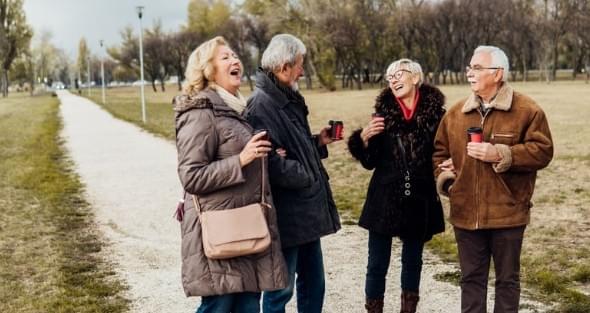Explore how being part of a supportive community can positively impact your health and longevity. We delve into the science behind social connections and their benefits for a longer, healthier life.

The Longevity Multiplier
When researchers pool decades of data, one headline keeps repeating: people with steady, supportive relationships live longer—roughly half again better odds of survival than those who are isolated. That advantage isn’t just about feeling happier (though you will). It shows up in hard outcomes: fewer heart attacks and strokes, lower rates of depression and cognitive decline, better recovery after illness. In public-health terms, connection behaves like a protective factor on par with the heavy hitters we all know—sleep, movement, diet. The difference? You can’t swallow community as a pill; you have to build it into your life.
Why People Power Your Physiology
Stress, tamed
Your stress system is a finely tuned alarm. Supportive people tell it, “You’re safe.” That message lowers baseline cortisol, takes the edge off blood pressure, and improves vagal tone (your body’s calm-down circuitry). Over months and years, that means less wear and tear on blood vessels, a quieter inflammatory state, and better sleep architecture. Translation: the kind of internal environment where ageing slows down rather than accelerates.
Immunity, upgraded
Immune cells listen to your social world. People with more varied, reliable ties mount stronger defences—fewer colds when exposed to the same virus, more robust responses to vaccines, faster bounce-back from minor infections. Loneliness, by contrast, nudges the immune system toward a “threat posture” (inflammation up, antiviral vigilance down). Your WhatsApp group and your walking club aren’t just nice—they’re part of your host-defence strategy.
Heart & brain insurance
Thin, fragile networks track with higher rates of coronary heart disease and stroke, and a greater risk of depression and dementia. Mechanistically, community helps on two fronts: it lowers the vascular damage driven by stress and inflammation, and it enriches cognitive reserve through conversation, problem-solving, humour, and shared routines. Your brain ages better when it’s regularly exercised in the company of others.
Habits that stick
We copy the people around us—often without noticing. Community makes good behaviour easier to start and harder to quit: evening walks, classes you’d skip alone, meal choices that follow the group norm, medication refills because someone asked, “Did you take it?” Over time, those micro-nudges compound into healthspan.
Belonging, Defined
Community isn’t headcount; it’s mutual care you can count on. Think in three layers:
Inner circle (3–5 people): You can call at 2 a.m. They know your history and your tells.
Crew (10–15): Teammates, neighbours, extended family, colleagues—people you see regularly with a shared rhythm or project.
Wider web: The broader network that keeps life textured—acquaintances at the café, the gym class, the book club, the parents on the touchline.
What matters is quality and consistency: reliability, reciprocity, low drama, shared expectations. Healthy communities make participation easy (“See you, same time next week?”). Red flags: one-way support, constant crisis, or groups that revolve around unhealthy norms.
Note for introverts: Belonging doesn’t require being loud or “on.” Two deep friendships and one well-chosen group you attend consistently can deliver nearly all the benefits.
Your Connection Playbook (Now with Muscle)
1) Make it recurring
Why it works: Rituals remove friction. Once something lands in the calendar, decision fatigue drops and attendance climbs.
Try this week: Pick a weekly anchor—Sunday roast, Wednesday walk, Thursday five-a-side. Set a shared reminder and default to “we’re on unless someone cancels.”
Level-up: Rotate hosting or leadership so no one burns out. Add a simple tradition (gratitude round, “rose/thorn” check-in) that keeps it meaningful.
2) Mix your circles
Why it works: Diverse ties protect you against shocks (a move, a breakup, a job change). Different circles offer different kinds of help—practical, emotional, professional, spiritual.
Try this week: Sketch your current map: family, friends, neighbours, hobby, faith, work. Circle the thinnest area and add one step: join a choir, Parkrun, community garden, language class, or local charity meeting.
Level-up: Every quarter, invite two people from different circles to the same low-key event. Cross-pollination grows your web.
3) Pair health with people
Why it works: Accountability plus enjoyment equals adherence. When the workout includes banter, you show up.
Try this week: Convert solo habits into social ones: swap treadmill for a walking club, YouTube yoga for a studio class, solo salads for a cook-together night with batch portions.
Level-up: Book a modest shared goal—5K, charity hike, learn-to-swim block, workplace step challenge. Put the date on the wall.
4) Be the helper
Why it works: Giving flips the script from “Do I belong here?” to “I’m useful here.” Purpose is a potent antidepressant—and a reliable attendance driver.
Try this week: Pick a micro-role: bring fruit to training, offer lifts, run the group timer, welcome new members.
Level-up: Volunteer with a local project for one hour a week. Skills trades count: fix a bike, edit a CV, show someone spreadsheets. Helping builds trust fast.
5) Design for bump-ins
Why it works: We underestimate the power of casual contact—those two-minute chats that keep relationships warm.
Try this week: Choose walkable routes, sit at a shared table, work in a co-working space one afternoon, or spend the first 10 minutes at the gym foyer before class. Start a simple street WhatsApp for lost parcels and local tips.
Level-up: Create a “third place”: monthly board-game night at the pub, courtyard coffee at 10 on Saturdays, bring-a-thermos sidelines spot at kids’ sport. Make it predictable.
Science Spotlight (What the evidence keeps finding)
Strong social relationships → meaningfully higher survival over time in large pooled analyses.
Isolation, loneliness, and living alone → higher mortality and more chronic disease—across ages and regions.
Diverse, reliable networks → fewer respiratory illnesses under the same exposure and better vaccine responses.
Social deficits → higher coronary heart disease and stroke risk; connection supports brain health and mood.
Mechanisms include lower stress hormones, quieter inflammation, healthier blood pressure, and stickier habits.
Bottom Line
